It’s no secret that using a laptop with an eGPU enclosure results in Thunderbolt and CPU bottlenecks, but just how much performance is being left on a table compared to putting the same graphics card in a desktop PC?
I’ve compared my i9-10900K system against the Razer Blade Stealth 13, connected to the Mantiz Saturn Pro Gen II eGPU enclosure. I’m testing both with MSI’s RTX 3090 Gaming X Trio graphics card to reduce GPU bottlenecks and reveal CPU and Thunderbolt limits.
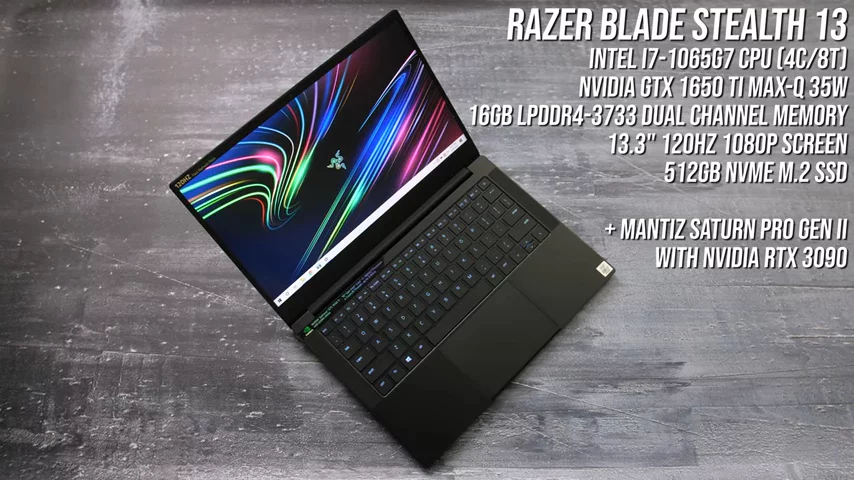 This laptop goes for around $1600 USD, which you could definitely use to build a nice gaming PC like I’ve got here instead, plus you’ve got to factor in around $300 for the eGPU enclosure, so we’re almost at $2000 here before even buying a graphics card. There are of course cheaper Thunderbolt capable machines though.
This laptop goes for around $1600 USD, which you could definitely use to build a nice gaming PC like I’ve got here instead, plus you’ve got to factor in around $300 for the eGPU enclosure, so we’re almost at $2000 here before even buying a graphics card. There are of course cheaper Thunderbolt capable machines though.
The reason I’m using the Blade Stealth is that due to it having Ice Lake with an integrated Thunderbolt controller, it actually ends up performing better in an eGPU setup than more powerful Comet Lake H based laptops, like the Dell G7 with 6 core 10750H processor.
Both setups were tested with the latest version of Windows and same Nvidia drivers, let’s get into the results, starting with 10 games followed by content creator workloads after.
Red Dead Redemption 2 was tested with the games benchmark tool. 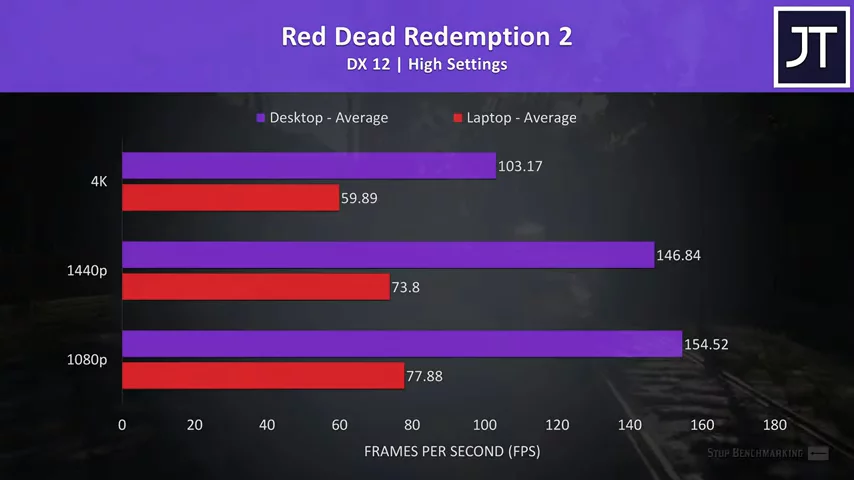 I’ve got the laptop plus 3090 eGPU shown by the red bars, and the desktop with same 3090 shown by the purple bars. I’ve also tested three resolutions, which are listed on the left with 1080p at the bottom, 1440p in the middle, and 4K up top. This game was around 100% faster on the desktop at 1080p and 1440p, then a little lower with a 72% lead at 4K.
I’ve got the laptop plus 3090 eGPU shown by the red bars, and the desktop with same 3090 shown by the purple bars. I’ve also tested three resolutions, which are listed on the left with 1080p at the bottom, 1440p in the middle, and 4K up top. This game was around 100% faster on the desktop at 1080p and 1440p, then a little lower with a 72% lead at 4K.
Battlefield 5 was tested in campaign mode by running through the same mission on both machines multiple times. 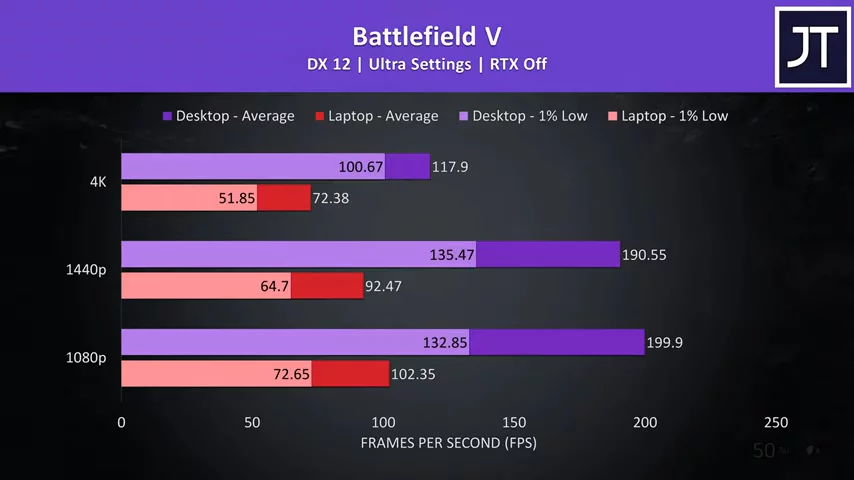 Even the 1% lows from the desktop are absolutely destroying the average FPS from the laptop and eGPU, but hey at the same time, to be fair to the laptop it is still managing to play fine above 60 FPS even at 4K ultra settings, which you can’t really do on most laptops without an eGPU.
Even the 1% lows from the desktop are absolutely destroying the average FPS from the laptop and eGPU, but hey at the same time, to be fair to the laptop it is still managing to play fine above 60 FPS even at 4K ultra settings, which you can’t really do on most laptops without an eGPU.
Shadow of the Tomb Raider was tested with the games built in benchmark.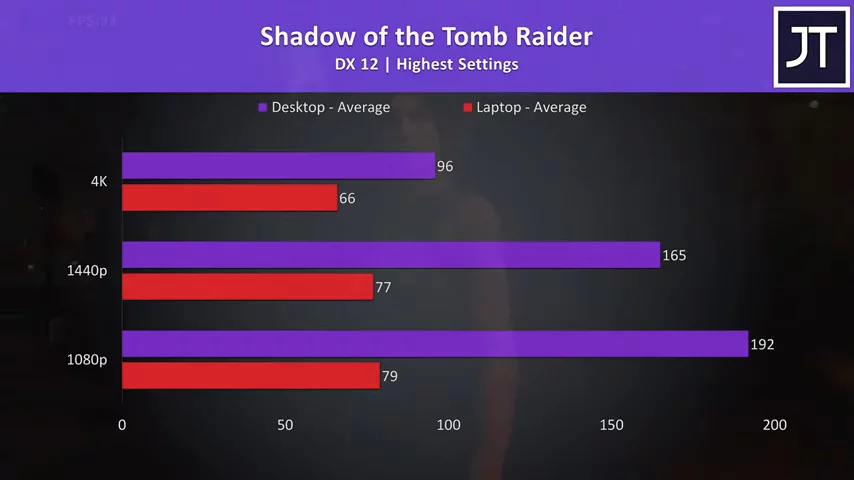 No question the desktop was far ahead here, with a 143% higher average frame rate at 1080p, though this lowers to a 45% lead at 4K, presumably as the GPU is better loaded here so the limitations in CPU and Thunderbolt start to become less of a factor.
No question the desktop was far ahead here, with a 143% higher average frame rate at 1080p, though this lowers to a 45% lead at 4K, presumably as the GPU is better loaded here so the limitations in CPU and Thunderbolt start to become less of a factor.
Let’s start with RTX off results in Control. 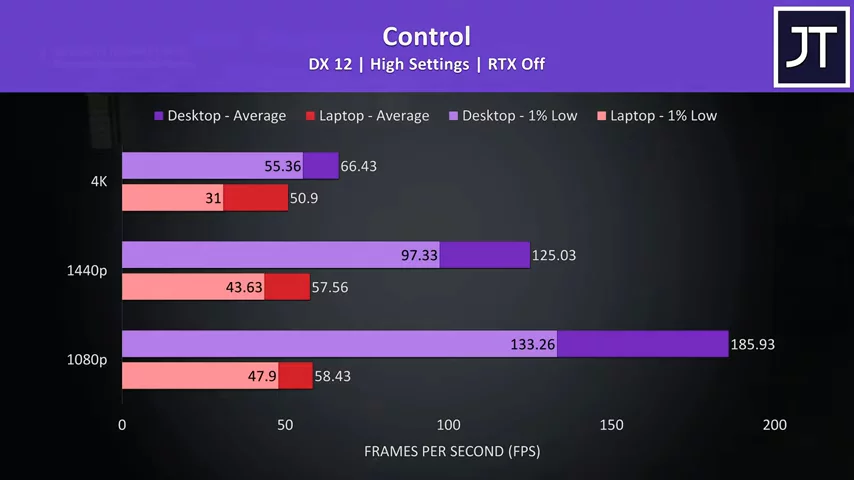 Again the desktop was smashing the laptop at lower resolutions, this game had the biggest difference out of all 10 titles tested, with the desktop more than three times faster than the laptop plus eGPU at 1080p. Once more at 4K the difference is far less pronounced, just a 30% higher frame rate from the desktop now.
Again the desktop was smashing the laptop at lower resolutions, this game had the biggest difference out of all 10 titles tested, with the desktop more than three times faster than the laptop plus eGPU at 1080p. Once more at 4K the difference is far less pronounced, just a 30% higher frame rate from the desktop now.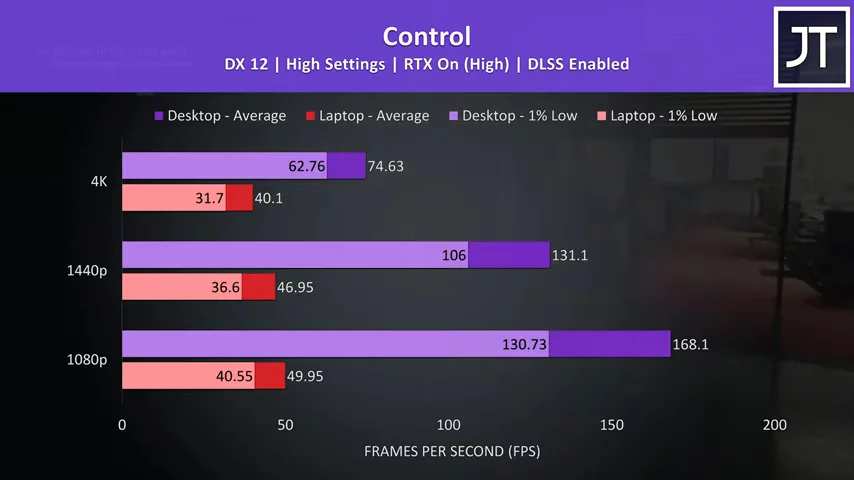 With RTX on and DLSS enabled though, the desktop sees bigger gains than what we just saw. At 4K now it’s 86% ahead of the laptop and eGPU setup, so based on this it would seem that ray tracing doesn’t work quite as well in the eGPU compared to a full blown desktop PC.
With RTX on and DLSS enabled though, the desktop sees bigger gains than what we just saw. At 4K now it’s 86% ahead of the laptop and eGPU setup, so based on this it would seem that ray tracing doesn’t work quite as well in the eGPU compared to a full blown desktop PC.
Metro Exodus was tested with the games benchmark tool. 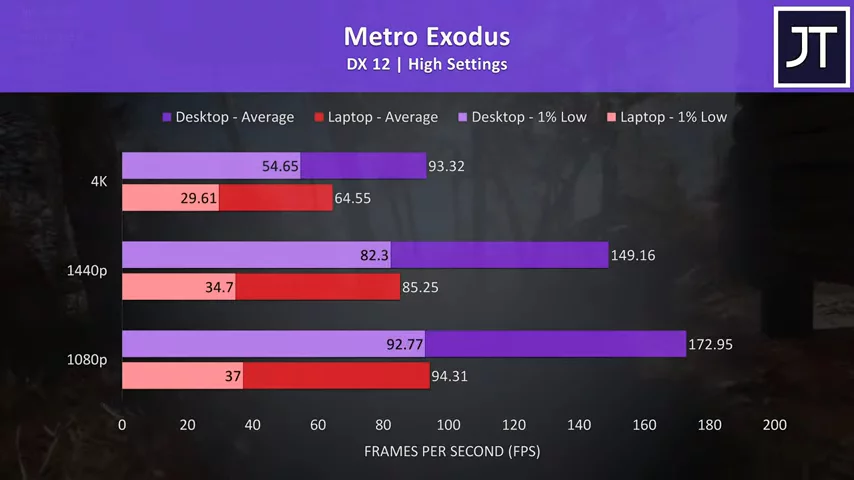 This was one of the smaller differences out of the 10 games tested, but still big improvements on offer from the desktop PC, where the 1% lows were near the averages from the laptop at 1080p and 1440p resolutions.
This was one of the smaller differences out of the 10 games tested, but still big improvements on offer from the desktop PC, where the 1% lows were near the averages from the laptop at 1080p and 1440p resolutions.
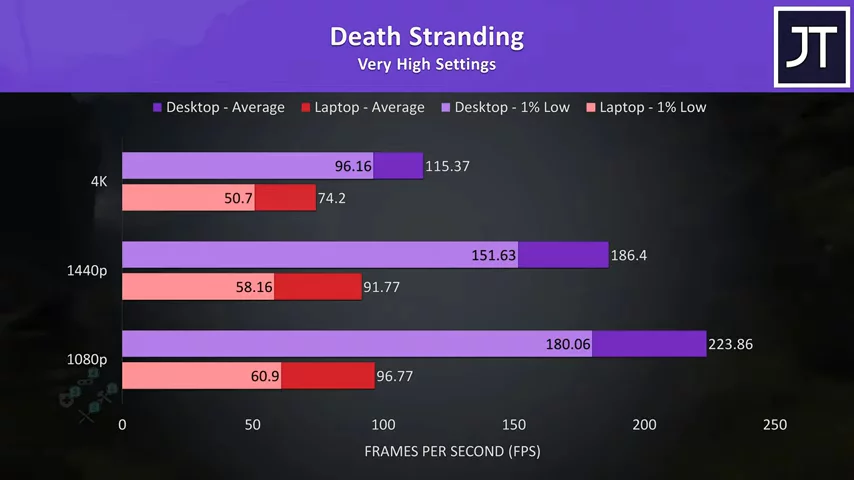 Death Stranding was slightly above the 10 game average at all resolutions, and that means massive frame rate improvements with the desktop, the 1% low on the desktop at 1080p is getting close to double the average frame rate from the laptop, crazy stuff.
Death Stranding was slightly above the 10 game average at all resolutions, and that means massive frame rate improvements with the desktop, the 1% low on the desktop at 1080p is getting close to double the average frame rate from the laptop, crazy stuff. 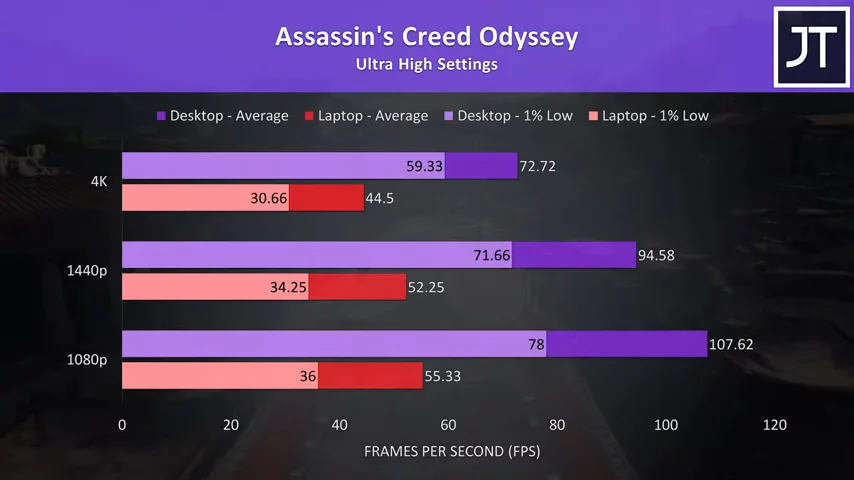 Assassin’s Creed Odyssey was tested with the games built in benchmark. Another easy win for the desktop machine, so let’s keep moving on.
Assassin’s Creed Odyssey was tested with the games built in benchmark. Another easy win for the desktop machine, so let’s keep moving on. 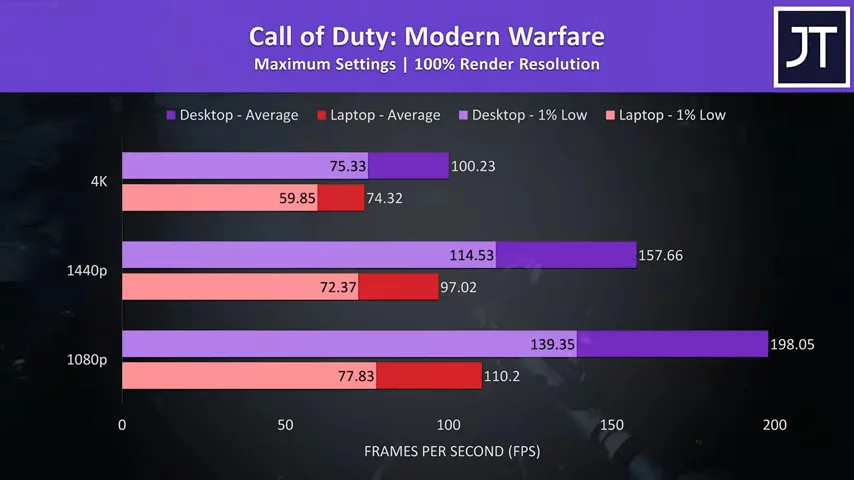 Call of Duty Modern Warfare saw the smallest difference between the two at 1080p and 1440p resolutions in terms of a percentage. Just let that sink in, because looking at the results here we can see there’s still quite a big difference.
Call of Duty Modern Warfare saw the smallest difference between the two at 1080p and 1440p resolutions in terms of a percentage. Just let that sink in, because looking at the results here we can see there’s still quite a big difference.
Rainbow Six Siege was tested with Vulkan using the games benchmark tool.  For some reason the eGPU setup was having heavy stuttering issues at the start of the benchmark, and that’s why it’s 1% lows are way down. I replicated this on two different laptops with different enclosures, so it seems to be some eGPU specific issue, though it was also the only Vulkan title tested so that could be part of it.
For some reason the eGPU setup was having heavy stuttering issues at the start of the benchmark, and that’s why it’s 1% lows are way down. I replicated this on two different laptops with different enclosures, so it seems to be some eGPU specific issue, though it was also the only Vulkan title tested so that could be part of it. 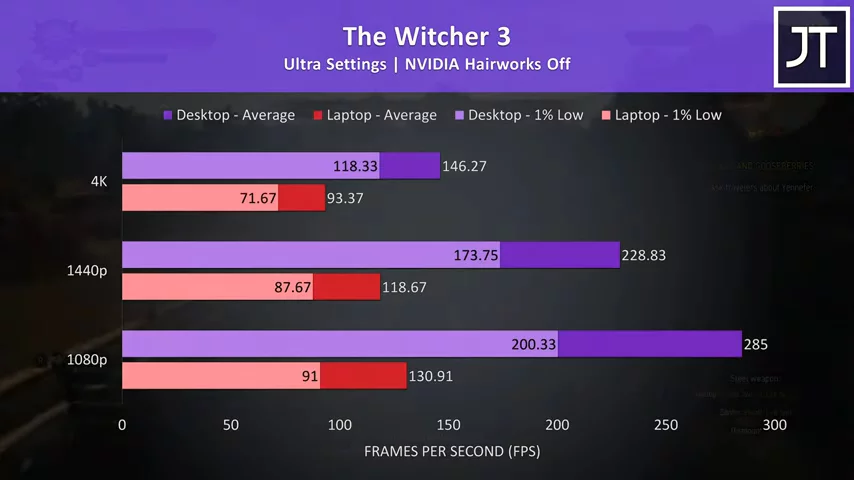 The eGPU setup was getting smashed in the witcher 3 by the desktop, but again like many games tested it’s important to keep in mind that being able to game at 4K max settings with the ultrabook in this setup is still quite impressive.
The eGPU setup was getting smashed in the witcher 3 by the desktop, but again like many games tested it’s important to keep in mind that being able to game at 4K max settings with the ultrabook in this setup is still quite impressive.
These are the performance differences in all games at 1080p.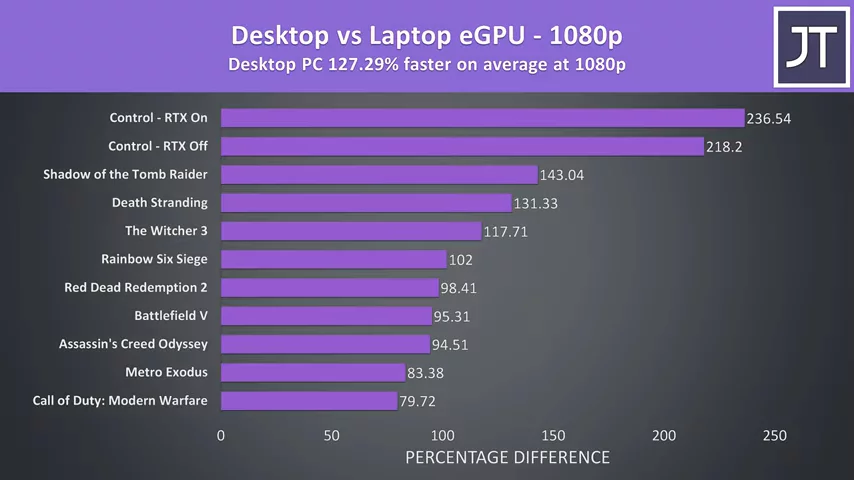 On average the desktop system with superior hardware was a massive 127% faster on average in terms of average frame rate. Even worst case we’re looking at about an 80% boost in Call of Duty, while Control was more than three times as fast.
On average the desktop system with superior hardware was a massive 127% faster on average in terms of average frame rate. Even worst case we’re looking at about an 80% boost in Call of Duty, while Control was more than three times as fast.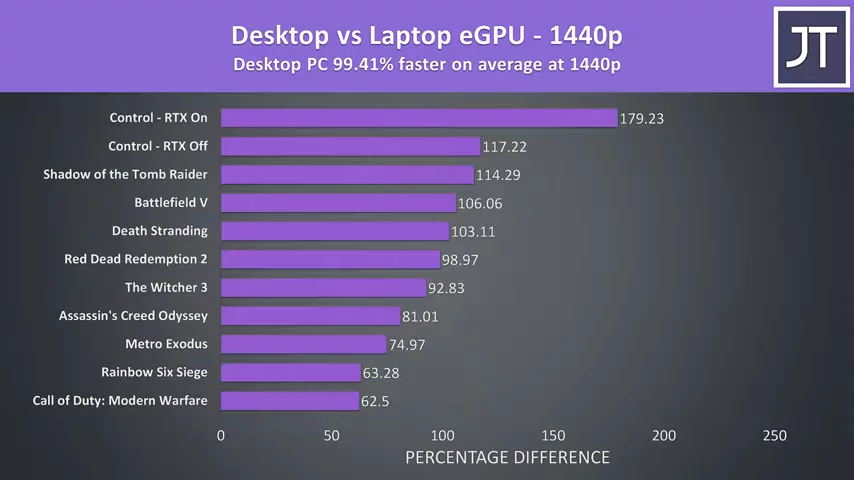 At 1440p the desktop PC is now just under 100% faster on average when compared to the laptop eGPU setup. Control was still the best result, performing far better, but even worst case in these games we’re still seeing more than a 60% higher frame rate from the PC.
At 1440p the desktop PC is now just under 100% faster on average when compared to the laptop eGPU setup. Control was still the best result, performing far better, but even worst case in these games we’re still seeing more than a 60% higher frame rate from the PC.
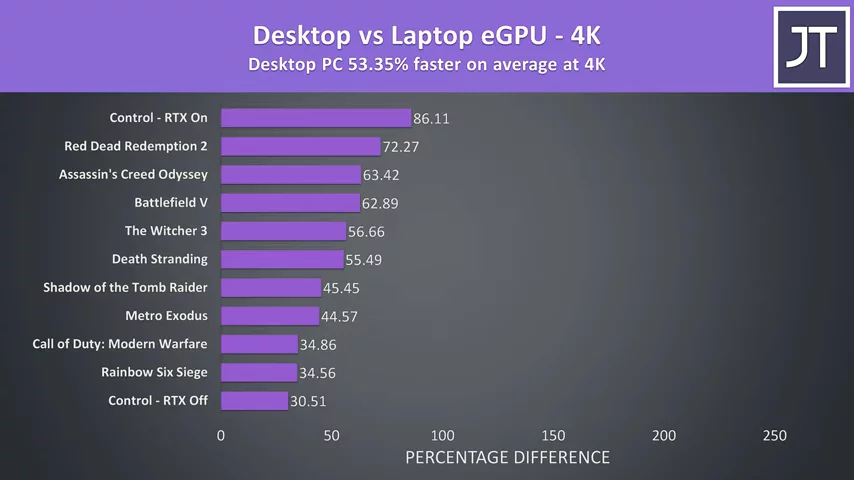 I’ve kept the same X Axis as the other graphs for 4K to give you an idea of how this compares. I believe we’re seeing the margins between the two decrease at higher resolutions as CPU and Thunderbolt bottlenecks start making less differences, a result of the GPU getting loaded up. In any case at 4K the desktop machine was still more than 50% faster than the laptop with the same graphics card.
I’ve kept the same X Axis as the other graphs for 4K to give you an idea of how this compares. I believe we’re seeing the margins between the two decrease at higher resolutions as CPU and Thunderbolt bottlenecks start making less differences, a result of the GPU getting loaded up. In any case at 4K the desktop machine was still more than 50% faster than the laptop with the same graphics card.
Outside of gaming, I found the scores from the V-Ray benchmark quite close. 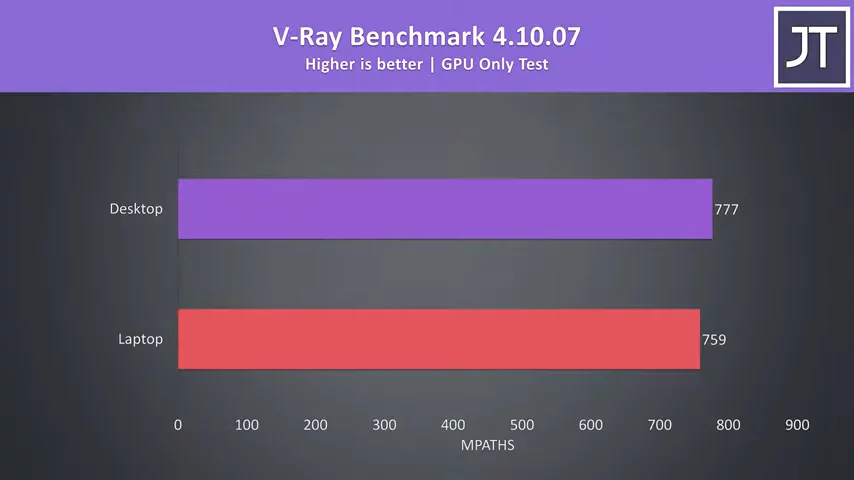 The Desktop PC was only around 2% better here, so it doesn’t seem that there’s anywhere near as much difference in more compute heavy workloads. This sort of setup could be much more viable if you’re not just planning on gaming.
The Desktop PC was only around 2% better here, so it doesn’t seem that there’s anywhere near as much difference in more compute heavy workloads. This sort of setup could be much more viable if you’re not just planning on gaming.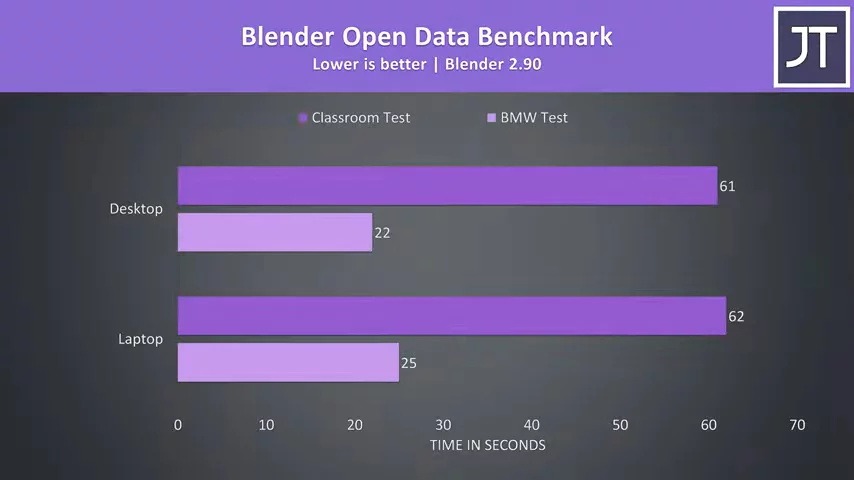 Likewise in the Blender OpenData benchmark, we’re just seeing the desktop complete the task a few seconds faster, so the eGPU can be quite capable in heavy GPU rendering tasks that are likely to not smash the Thunderbolt link and processor super hard.
Likewise in the Blender OpenData benchmark, we’re just seeing the desktop complete the task a few seconds faster, so the eGPU can be quite capable in heavy GPU rendering tasks that are likely to not smash the Thunderbolt link and processor super hard. 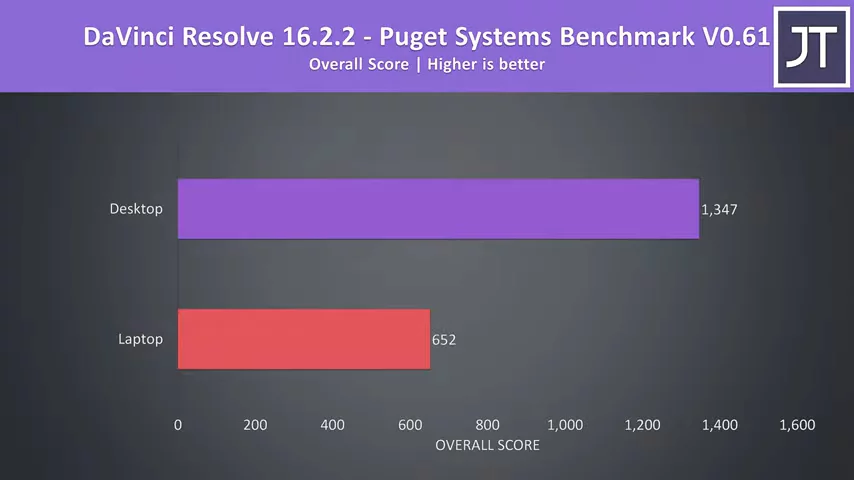 DaVinci Resolve was doing much better on the desktop, I’m guessing in this video editing workload the processor matters a bit more, and that overclocked 10900K is on a different plane of existence to the quad core chip in the Blade Stealth.
DaVinci Resolve was doing much better on the desktop, I’m guessing in this video editing workload the processor matters a bit more, and that overclocked 10900K is on a different plane of existence to the quad core chip in the Blade Stealth.
As expected in games the frame rates from the desktop system are much better when compared to the laptop with eGPU, but at the same time though I think it’s impressive what this was able to deliver. This is a lower powered 13” machine, and we were able to basically play 4K games with good settings without much problem. It was definitely usable.
In the end, I think it really comes down to how much you value portability. Good luck taking bit PC to the office or work compared to this laptop and then just docking with the eGPU when you get home. In many cases it’s cheaper to buy a mid range gaming PC and if you need portability then maybe a smaller laptop, or maybe just a mid range laptop with good graphics card, either way there are a few different options so you can pick the one that suits your budget and requirements.
An eGPU setup is definitely niche and requires a fair bit of money to get started. But for those that just want one system to do it all, value portability, and have the money, an eGPU setup like this is definitely an option.
Obviously the CPU differences between these two setups is completely unfair, so check out this other review if you want to see how the CPU in the Razer Blade Stealth compares with the Dell G7, as that’s using the 6 core 10750H with higher power limit and higher clock speed. The results are very interesting and not at all what I was expecting.
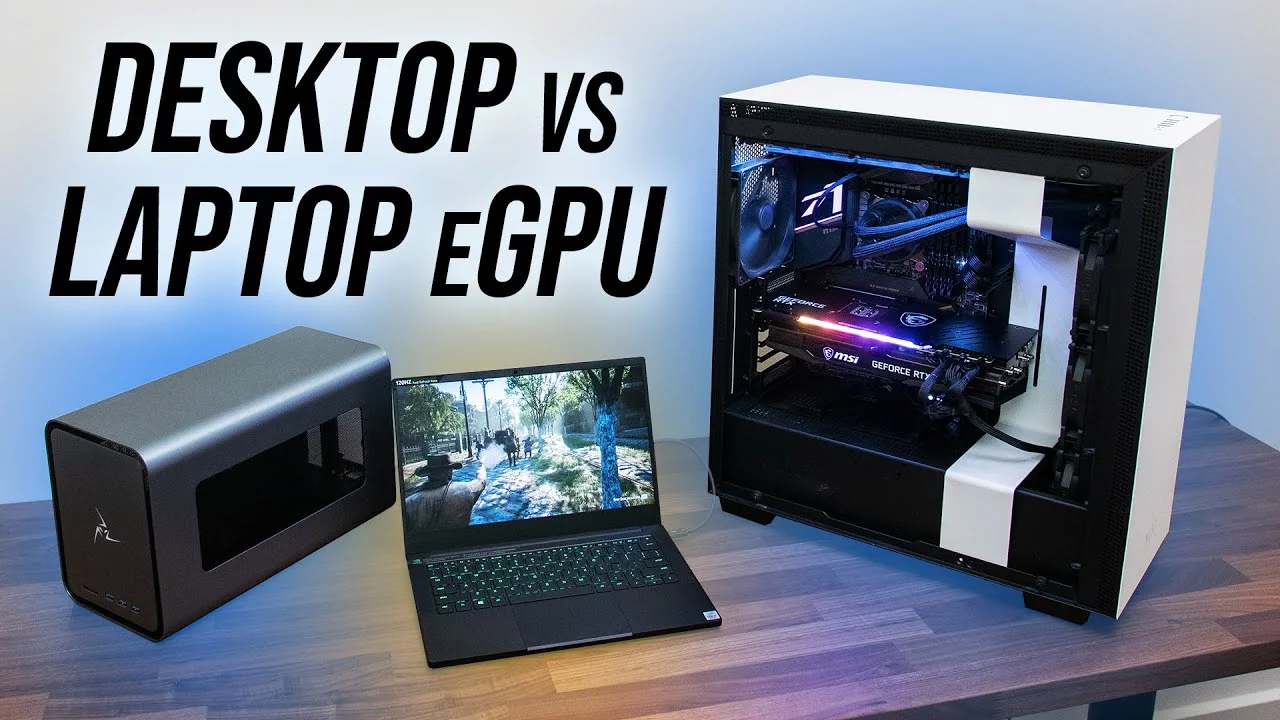

No comments yet